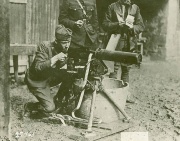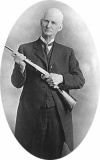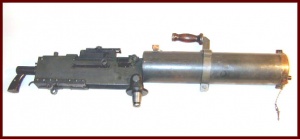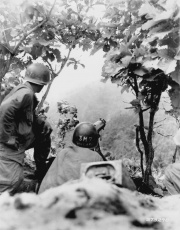M1917 Browning machine gun
| |||||||||||||||||||||||||||||||||||||||||||
The Browning Model 1917 Machine Gun is a heavy machine gun used by the United States armed forces in World War I, World War II, Korea, and to a limited extent in Vietnam and by other nations. It was a belt-fed water-cooled machine gun that served alongside the much lighter air-cooled Browning M1919. It was used at the battalion level, and often mounted on vehicles (such as a jeep). There were two main iterations of it; the M1917, which was used in World War I, and the M1917A1 which was used after. The M1917 was used on the ground and some aircraft, and had firing rate of 450 round/min; the M1917A1 had a firing rate of 450 to 600 round/min.
Contents |
Design and Development

In 1901, John Moses Browning was issued US patent 678937 for a recoil powered automatic gun. The design initially met with little interest in the US military. Browning's Model 1917 was essentially an updated version of this weapon. The Browning is a water cooled heavy machine gun, though some versions that did not use a water jacket were experimented with; the M1919 was preferred. Unlike many other early machine guns, the M1917 had nothing to do with Maxim's design. It was much lighter than Maxim type guns such as 62 kg German Machinegewehr 08 and some kilos lighter than the contemporary Vickers machine gun, while still being highly reliable. The only similarity is the use of some of the propellant energy to power the reloading mechanism.
The Army Ordnance Department initially showed little interest in Browning's design, but after war was declared in April 1917, Browning was able to arrange a test. The first test was a success, but the Army demanded a second test a short time later. In the second test, Browning fired the weapon in two lengthy bursts of 20,000 rounds each without a single mishap. The Ordnance Board was impressed but was unconvinced that the same level of performance could be achieved in a production model. Browning produced a second weapon which he fired in a third test continuously for 48 minutes (over 21,000 rounds). Finally convinced, the Army adopted the weapon as its principal heavy machine gun, utilizing the M1906 .30-06 cartridge with a 150-grain, flat-base bullet.
Until that time, the Army had used a variety of older machine guns like the M1895 Colt-Browning machine gun "Potato Digger" (which Browning had also designed) and weapons like the Maxim Gun, Benet-Mercies M1909, and the Hotchkiss M1914 machine gun. Although the Model 1917 was intended to be the principal US Army heavy machine gun in the war, the Army was in fact forced to purchase many foreign weapons - the French-produced Hotchkiss 8 mm machine gun was actually the most numerous heavy machine gun used by the American Expeditionary Force.
In 1926, the Browning's rear sight was revised to incorporate scales for both the new M1 Ball (172-grain boat-tail bullet) and the M1906 (150-grain flat-base bullet) ammunition.[1] With M1 ball, the M1917 had a maximum range of about 5,500 yards; with M2 ammunition, about 3,500 yards.).[1] The rear sight had a battle sight as well as a raised leaf-type sight suitable for employment against either ground or air targets.[1]
Service
The M1917 saw limited service in the latter days of the First World War. Because of production delays, only about 1,200 Model 1917s saw combat in the conflict, and then only in the last two and a half months of the war. They equipped about a third of the divisions sent to France; the others were equipped equally with machine guns bought from the French or the British Vickers machine guns built by Colt in the US. Where the Model 1917 did see action, its rate of fire and reliability were highly effective.
The Model 1917A1 was again used in the Second World War, and was primarily used with the M2 ball, tracer, and armor-piercing ammunition introduced just prior to the outbreak of hostilities. Some were supplied to the UK in the .303 caliber for use by the Home Guard; all production of the Vickers .303 being needed to resupply the equipment abandoned during the Fall of France. The M1917's weight and bulk meant it was generally employed as a fixed defense or battalion or regimental support weapon. At the fierce battle of Momote Airstrip in the Admiralties, the U.S. Army's 5th Cavalry machinegunners killed several hundred Japanese in one night using their M1917 Brownings; one gun was left in position after the battle as a memorial to the desperate struggle.[2]
The Model 1917 was called to service again in the Korean War. The Model 1917 was slowly phased out of military service in the late 1960s in favor of the much lighter, and more suitable for modern warfare, M60 machine gun. The attributes of the Model 1917 and similar weapons such as the Vickers machine gun - continuous fire from a static position had been rendered useless by the movement to highly mobile warfare. Many of the 1917's were given to South Vietnam. The gun did continue to see service in some Third World armies well into the later half of the 20th century.
Variants
US military variants

M1917
- initial model
M1917A1
- M1917's "rearsenaled" at the US Arsenal at Rock Island in order to extend service life.
M1918
- Air-cooled aircraft version of the M1917. Developed during the First World War, the M1918 arrived too late, but became the dominant weapon of its type in US service until the development of the M1919.
- Features a heavier barrel, but lighter barrel jacket as compared to the M1917.
- A supposed sub-variant, the M1918M1, was developed a flexible version of the fixed M1918.
International Variants & Designations
The M1917 pattern has been used in countries the world over in a variety of forms. In certain cases a new designation was applied by the user nation.
Ksp m/36
- Swedish designation for M1917s in 6.5 x 55 mm for infantry support or 8 x 63 mm for AA-use. In the mid 1970s all guns were rebarreled in 7.62 x 51 mm NATO.
Ckm wz.30
- Polish-built clone of the M1917 chambered in 8 mm (technically 7.92x57 mm) Mauser.
M/29
- Norwegian designation for the Colt M1917 (mentioned in the following section) in 7.92 mm, used as the standard HMG and anti-aircraft weapon for the Norwegian Army from 1929 to 1940. Replaced the Hotchkiss M1914 machine gun in Norwegian service.[3] The M/29 saw sterling service in the 1940 Norwegian Campaign, often deployed as the only heavy weapon of Norwegian front line units.
Commercial variants
Colt Model 1917 and Model 1928
- Colt commercially produced the M1917, and also under contract to the Argentine government a number of slightly modified guns as the Model 1928.
- The Model 1928 featured a thumb safety, Type A flash hider, and a mount for a panoramic sight unit.
Colt MG38, MG38B, and MG38BT
- Derivatives of the Colt M1928 for general commercial sale.
- The 38 and 38B were water-cooled with a barrel jacket threaded inside the trunnion, unlike the M1917 and Colt Model 1928.
- The 38BT was a short heavy barreled air-cooled weapon resembling the Browning M1919A2, designed for use in tanks.
- The 38 series also features spade grips, not found on the rest of the M1917 and the majority of the M1919 families.
Derivatives
A simplified, air cooled version of the weapon, the Model 1919 was adopted after World War I and saw action in World War II, the Korean War, Congo crisis, and the Vietnam conflict. It is still in use today by various militaries but more popular as a mounted vehicle weapon due to the usage of GPMGs for the field.
Users
- Argentina
- Norway
- Sweden
- United States
In Popular Culture
A Browning M1917 machine gun is the centerpiece of the climactic shootout in Sam Peckinpah's 1969 film The Wild Bunch, with the major protagonists all operating the machine gun during the course of the shootout.
A Browning M1917 machine gun plays a role in the final battle sequence of the 1943 movie Bataan, about the doomed but heroic defense of the Philiphines by heavily outnumbered US and Filipino forces at the start of World War II. Note: Two of the three machine guns used in the film are Browning M1917s. However, while the third used in the final battle sequence is suppose to be also a M1917, it is in fact a British M1912 Vickers machine gun.
In a Peanuts Sunday comic strip by Charles Schulz, Linus van Pelt, who is spending the night at Charlie Brown's house, expresses worry over intruders. Charlie Brown allays Linus' fears by directing his attention to Snoopy, who is depicted atop his doghouse armed with a Browning M1917.
Resources
| Gun Owners' Resource has the following relevant documents available for free download for the M1917 Browning machine gun and/or its variants: |
- THE BROWNING HEAVY MACHINE GUN .300 calibre model 1917 (water cooled) MECHANISM Made Easy - Gale & Polden Ltd, London Aldershot and Portsmouth, 1942 (3.5 MB .PDF file, 35 pages)
The following diagrams are also available for reference for the M1917 MG and/or its variants:
Footnotes
- ↑ 1.0 1.1 1.2 Dunlap, Roy, Ordnance Went Up Front, Samworth Press (1948), p. 309
- ↑ Dunlap, Roy F., Ordnance Went Up Front, Samworth Press (1948), p. 310
- ↑ Norwegian Army weaponry in 1940
See also
- Kjellman machine gun
- Skoda M1909 machine gun
- M1919 Browning machine gun
- M240 machine gun
- MG 131
- M2 Browning machine gun
External links
| This article is part of a series on the works of John Moses Browning | ||
|---|---|---|
| Semi-automatic pistols | FN M1900 · Colt M1900 · Colt M1902 · FN Model 1903 · M1903 Pocket Hammer · M1903 Pocket Hammerless · M1908 Vest Pocket · FN Model 1910 · M1911 · Colt Woodsman · Baby Browning · Hi-Power |  |
| Rifles | Winchester Model 1885 · Winchester Model 1886 · Winchester 1892 · Winchester Model 1894 · Winchester Model 1895 · Remington Model 8 · Remington Model 24 · FN Trombone | |
| Shotguns | Winchester Model 1887 · Winchester Model 1897 · Browning Auto-5/Remington Model 11 · Remington Model 17 · Savage Model 520 · Browning Superposed · Ithaca 37 | |
| Machine guns | Colt-Browning M1895 · Browning M1917 · Browning Automatic Rifle · Browning M1919 · M2 Machine Gun | |
| Cartridges | .25 ACP · .32 ACP · .38 ACP · .380 ACP · .45 ACP · .50 BMG | |






